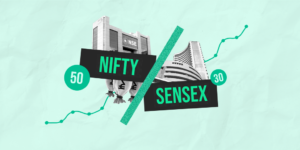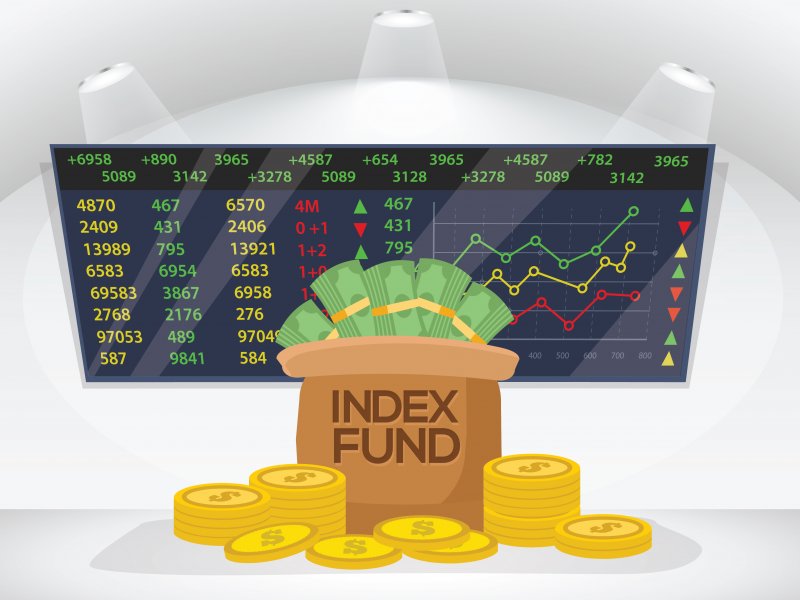An Index Fund replicates the portfolio of an index and provides returns accordingly. They are passive funds that imitate the performance of a particular stock market index like NIFTY50, SENSEX, etc. The asset allocation is similar to the composition of the underlying index. Hence, the returns are close to the underlying index. Since 1976, different types of index funds have evolved in India. Investors can invest in index funds to have exposure to disparate asset classes and investment styles.
For instance, an index fund replicates NIFTY50, which has fifty stocks. Hence, the index fund portfolio comprises all the fifty stocks in the NIFTY50 index in the same proportions. An index is a group of securities which could have equity-related instruments, debt market instruments, etc. As mentioned earlier, index funds are passive. The fund managers add or remove a particular stock from the portfolio according to the index composition. Active funds provide more returns than the underlying index, whereas passive funds try to match their performance with the index. Index Funds provide returns that equal the benchmark marginally. The difference between the returns of the underlying index and index funds is a tracking error that the fund managers try to avoid.
The article is about seven different types of index funds in India and factors to consider before investing in index funds.
Factors to consider before investing in Index Funds
- Firstly, index funds are prone to volatility and risks as they follow a particular index. Index Funds provide excellent returns amid a rallying market. However, one must switch to active funds during a falling market as index funds lose value during a downturn. Hence, one must have a mixture of active and passive funds in their portfolio.
- Secondly, index funds replicate an index and provide returns that match the index performance. They do not deliver market-beating returns. However, they could provide returns lower than the index due to tracking errors.
- Thirdly, the expense ratio of index funds is less than active funds as there is passive management and the fund managers need not formulate an investment strategy. If two index funds follow BSE SENSEX, their expense ratio might differ. Therefore, the fund that has a lower expense ratio provides more returns.
- Further, index funds fluctuate in the short-run (less than one year). Hence, index funds are best for investors who want to invest money for a long tenure.
- Lastly, the risk-return factor and long-term investment feature of index funds help in wealth creation or retirement planning.
Different Types of Index Funds in India
As mentioned earlier, there are seven types of index funds in India. Every index fund has a different composition and risk factor.
Broad Market Index Funds
A broad market index fund replicates an index which indicates the performance of the major segment of the stock market. For instance, an index fund replicating BSE SENSEX 500 is a broad market fund as the underlying index consists of stocks from different sectors and market capitalizations. Therefore, broad market index funds replicate the performance of the entire stock market. For instance, Motilal Oswal NIFTY500 Fund tracks the performance of NIFTY500 and gives exposure to large, mid, small and micro-cap stocks.

Market Capitalization Index Funds
The weightage of stock market indices depends on the market capitalization. For instance, NIFTY50, SENSEX, NIFTY 200, etc. The risk and returns vary between large (100 stocks by market cap), mid (101st to 250th stocks), and small-cap (251st and below) stocks. As we know, stocks fluctuate. Hence, every stock is undervalued or overvalued at a certain time. A market cap index provides more weightage to overvalued stocks and lower weightage to undervalued stocks. When one invests more money in the index funds, there is an increase in the price of some stocks at the expense of others. Hence, index funds extend the bull run and make stocks expensive. Further, when these stocks become unattainably expensive, there is a market correction. But the short-term volatility should not affect the long-term investors.

Sector-Based Index Funds
Sector-Based Funds or ETFs invest in sectoral indices such as banking, healthcare, consumption, etc. They cater to broader categories such as banking funds. However, there are narrower and more specific index funds like private bank funds. For example- Axis Healthcare EFT, SBI EFT IT, etc.

International Index Funds
Mutual Funds have launched schemes that follow international indices and provide returns accordingly. It gives exposure to foreign markets to Indian investors. Recently, funds also track multiple foreign indices at once. It also helps in the diversification of funds. For example- Mirae Asset NYSE FANG+ ETF FoF replicates NYSE FANG+ Index, which comprises the top ten technology and internet stocks such as Alibaba, Tesla, Facebook, Apple, Alphabet, etc.

Debt Index Funds
Debt instruments have two risks- credit and interest risk.
Interest risks arise due to changes in bond prices due to fluctuating interest rates. Credit risks arise due to default in payment of bonds by the issuer. These funds are not popular in India. However, target maturity index funds help to reduce credit and interest risk.
ICICI Prudential PSU Bonds Plus SDL 40:60 Index Fund (September 2027) invests in eight AAA- PSU Bonds and 20 State Development Loans in the ratio of 40:60. Here, the maturity date is 30th September 2027, eliminating interest risk if held for that period. Since the instruments are AAA-rated, credit risk becomes negligible.
Other examples are IDFC Gilt 2028 Index Fund, Axis AAA Bond Plus SDL ETD- 2026 Maturity FoF, etc.

Equal Weight Index Funds
Equal Weight Index has stocks with the same weight. It ignores the market cap and invests funds, in equal proportion, in the particular index. For instance, NIFTY 50 has stocks as per market cap- Reliance (12.8%), HDFC Bank (8.10%), Infosys (7.66%), etc. However, in equal weight index, all fifty companies have an equal weight of 2% (approximately). Therefore, an equal weight index balances a portfolio to avoid markets’ over and underweighting. Moreover, it is more value-oriented and diversified than the market-cap-weighted index.
Even the sector-based allocation in equal weight index is more diverse than the market-weighted index. Have a look at the table below:
| Sector | Market Cap Weighted NIFTY 50 Index | Equal Weight NIFTY 50 Index |
| Financials | 36.7 | 18.1 |
| Technology | 16.7 | 9.5 |
| Energy | 14.4 | 14.5 |
| FMCG | 7.4 | 9.3 |
| Automobile | 5.5 | 12.6 |
| Construction | 5.3 | 8.1 |
Also, the equal-weight index provides better returns than the market-weighted index funds in a long tenure.

Factor-Based Index Funds
The market capitalization method is the most popular way to create an index but not the only one. Various factors such as valuation ratios, book value, cash flows, etc., can help form an index. They help in determining the financial metrics and characteristics of a stock. Some of the factors other than market cap are:
- Value- It compares the stock price to its fundamental value, for which one uses price to book value ratio, P/E ratio, etc.
- Dividend Yield- It determines the growing and above-average dividend yield stocks with the help of stocks’ yield.
- Momentum- It shows the stocks’ performance over the preceding three to six months with the help of alpha.
- Volatility- It determines the stocks’ below and above-average volatility with the help of beta and standard deviation.
- Quality- It looks after profitability characteristics such as return on equity, cash flows, dividend, financial leverage, etc.
*Beta determines the volatility of a stock compared to the benchmark index. On the other hand, alpha shows the stock’s performance to the overall market.
Mutual Funds are launching factor funds like smart-beta funds, where they invest funds in stocks based on volatility. NIFTY Low Volatility 50 Index Funds is an example.
For example, Edelweiss NIFTY 100 Quality 30 Index invests in 30 stocks in the NIFTY 100 index based on characteristics such as cash flow, debt, return on capital employed, etc.
Some mutual fund houses have launched multi-factor funds, where they consider two to three factors at once. For instance, ICICI Prudential Alpha Low Vol 30 is a two-index fund considering momentum and volatility factors.





